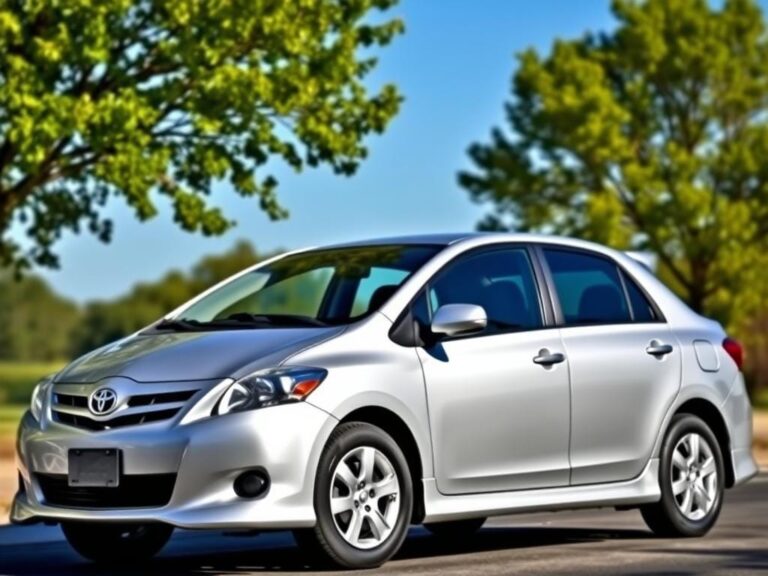How to Maintain Your Toyota RAV4 in 7 Easy Steps?
The Toyota RAV4 maintenance schedule serves as your roadmap to preserving your vehicle’s exceptional performance and longevity. When you follow a systematic approach to caring for your RAV4, you’re investing in years of reliable transportation and optimal resale value. Your compact SUV deserves meticulous attention to detail, and understanding the critical maintenance intervals can save you thousands in unexpected repair costs while ensuring peak operational efficiency.
Proper maintenance extends far beyond simple oil changes. You need a comprehensive understanding of your RAV4’s intricate systems and their specific service requirements to maximize your investment’s potential.
Table of Contents
Understanding Your Toyota RAV4 Maintenance Schedule Framework
Your RAV4’s maintenance schedule follows Toyota’s ToyotaCare program, which provides structured service intervals based on mileage and time parameters. This systematic approach ensures optimal vehicle performance across all operational systems. The schedule typically divides maintenance into minor and major service categories, with intervals occurring every 5,000 to 10,000 miles depending on your driving conditions and vehicle year.
Understanding these intervals helps you anticipate costs and schedule appointments proactively rather than reactively addressing mechanical failures.
| Maintenance Interval | Service Type | Key Components | Estimated Cost Range |
|---|---|---|---|
| 5,000 miles | Minor Service | Oil change, visual inspection | $45-$85 |
| 10,000 miles | Standard Service | Filter replacement, fluid checks | $150-$250 |
| 20,000 miles | Intermediate Service | Tire rotation, brake inspection | $200-$350 |
| 30,000 miles | Major Service | Transmission service, coolant flush | $400-$600 |
| 60,000 miles | Comprehensive Service | Timing belt, spark plugs | $800-$1,200 |
Step 1: Master Your Engine Oil and Filter Maintenance
Your RAV4’s engine oil serves as the lifeblood of mechanical operation, requiring consistent attention to maintain optimal viscosity and contamination levels. Toyota recommends synthetic oil changes every 10,000 miles under normal driving conditions, though severe conditions may necessitate more frequent intervals.
Monitor your oil level regularly using the dipstick. Check color and consistency monthly. Dark, thick oil indicates degradation requiring immediate replacement. Your oil filter requires simultaneous replacement to prevent contaminant circulation through freshly installed lubricant.
Consider these factors when determining oil change frequency:
- Extreme temperature exposure (below 32°F or above 90°F consistently)
- Frequent short-distance driving (under 5 miles per trip)
- Dusty or sandy environmental conditions
- Trailer towing or heavy payload hauling
- Stop-and-go traffic patterns
Step 2: Optimize Your Fluid System Maintenance
Your RAV4 contains multiple fluid systems requiring periodic attention to maintain operational integrity. Each fluid serves specific purposes and deteriorates at different rates based on usage patterns and environmental exposure.
Critical fluids include brake fluid, transmission fluid, coolant, power steering fluid, and windshield washer fluid. You should inspect fluid levels monthly and replace them according to manufacturer specifications. Contaminated or low fluid levels can cause catastrophic system failures requiring expensive repairs.
Brake fluid absorbs moisture over time, reducing its effectiveness and potentially causing brake failure. Replace it every 30 months regardless of mileage. Transmission fluid lubricates complex internal components and should be serviced every 60,000 miles for optimal performance.
Step 3: Implement Comprehensive Tire Care and Rotation
Your RAV4’s tire maintenance directly impacts safety, fuel efficiency, and handling characteristics. Proper tire care extends tread life and ensures optimal traction across various driving conditions. Regular rotation prevents uneven wear patterns that can compromise vehicle stability.
Rotate your tires every 5,000 to 7,500 miles following the recommended pattern for your specific RAV4 configuration. Front-wheel drive models typically use a forward cross pattern, while all-wheel drive variants require different rotation sequences.
Monitor tire pressure monthly using a reliable gauge. Underinflated tires reduce fuel economy and increase wear rates. Overinflation causes center tread wear and harsh ride quality. Maintain pressure according to the placard located on your driver’s door jamb.
Step 4: Execute Thorough Brake System Inspections
Your RAV4’s brake system requires regular evaluation to ensure stopping power remains consistent and safe. Brake pads wear gradually through normal use, requiring replacement before metal-to-metal contact occurs.
Inspect brake pads every 12,000 miles or whenever you rotate tires. Look for wear indicators or listen for squealing sounds during braking. These warning signs indicate approaching replacement intervals.
Brake rotors may require resurfacing or replacement depending on wear patterns and thickness measurements. Warped rotors cause pedal pulsation and reduced braking effectiveness. Professional inspection ensures accurate assessment of rotor condition.
Step 5: Maintain Your Air Filtration Systems
Your RAV4 contains multiple air filters protecting engine and cabin environments from contaminants. The engine air filter prevents debris from entering combustion chambers, while the cabin air filter purifies air entering your passenger compartment.
Replace your engine air filter every 30,000 miles under normal conditions or more frequently in dusty environments. A clogged filter reduces engine performance and fuel economy. Visual inspection reveals dirt accumulation requiring replacement.
The cabin air filter requires replacement every 15,000 to 25,000 miles depending on driving conditions. Signs of replacement needs include reduced airflow from vents, unusual odors, or excessive dust in the cabin despite closed windows.
Step 6: Service Your Battery and Electrical Systems
Your RAV4’s electrical system powers numerous components requiring consistent voltage and amperage. The battery serves as the primary power source when the engine isn’t running and supplements the alternator during high-demand situations.
Test your battery annually after three years of service. Clean terminals regularly to prevent corrosion buildup that impedes electrical flow. Loose connections cause starting problems and electrical system malfunctions.
Inspect belts and hoses during routine maintenance intervals. Cracked or frayed belts can break unexpectedly, causing cooling system failure or loss of power steering assistance. Replace worn components before failure occurs.
Step 7: Follow Your Toyota RAV4 Maintenance Schedule Precisely
Adherence to your manufacturer’s recommended maintenance schedule ensures warranty compliance and optimal vehicle performance. Keep detailed records of all service performed, including dates, mileage, and parts replaced.
Use genuine Toyota parts or equivalent quality components to maintain reliability and performance standards. Inferior parts may cause premature failures and void warranty coverage.
Schedule maintenance appointments in advance to avoid emergency repairs and higher costs. Many dealers offer service reminders and online scheduling for convenience.
Advanced Maintenance Considerations for Optimal Performance
Beyond basic maintenance requirements, consider additional services that enhance your RAV4’s longevity and performance. Fuel system cleaning removes deposits that accumulate over time, improving engine efficiency and reducing emissions.
Transmission services beyond fluid changes include filter replacement and internal component inspection. These comprehensive services prevent costly transmission rebuilds and maintain smooth shifting characteristics.
Consider climate-specific maintenance adjustments based on your geographical location. Cold climates require different oil viscosities and additional corrosion protection. Hot climates demand enhanced cooling system attention and more frequent fluid changes.

Technology Integration in Modern Maintenance
Contemporary RAV4 models feature maintenance reminder systems that alert you to approaching service intervals. These systems calculate maintenance needs based on driving conditions, engine hours, and environmental factors rather than simple mileage accumulation.
Reset maintenance reminders after completing required services to ensure accurate future notifications. Consult your owner’s manual for specific reset procedures, as methods vary between model years.
Conclusion: Protecting Your Investment Through Diligent Care
Your Toyota RAV4 maintenance schedule represents the foundation of vehicle longevity and reliable performance. When you commit to following these seven essential steps consistently, you’re protecting a significant financial investment while ensuring safe, dependable transportation for years to come.
Regular maintenance prevents minor issues from developing into major expensive repairs. Your proactive approach to vehicle care demonstrates responsible ownership and preserves resale value when you eventually decide to upgrade.
The time and money invested in proper maintenance pale in comparison to the costs associated with neglect and emergency repairs. Your RAV4 will reward your diligent care with hundreds of thousands of miles of faithful service.
Don’t wait for problems to manifest before taking action. Schedule your next maintenance appointment today and begin implementing these proven strategies to maximize your RAV4’s potential. Your future self will thank you for the foresight and dedication you demonstrate through consistent, thorough vehicle care.
FAQs About Toyota RAV4 Maintenance Schedule
How often should I follow the Toyota RAV4 maintenance schedule for oil changes?
Your Toyota RAV4 maintenance schedule typically requires oil changes every 10,000 miles when using synthetic oil under normal driving conditions. However, severe driving conditions such as frequent short trips, extreme temperatures, or dusty environments may necessitate more frequent intervals of 5,000 to 7,500 miles to ensure optimal engine protection and performance.
What happens if I don’t follow the recommended Toyota RAV4 maintenance schedule?
Neglecting your Toyota RAV4 maintenance schedule can result in voided warranty coverage, decreased fuel efficiency, premature component failures, and significantly higher repair costs. Critical systems like the engine, transmission, and brakes may experience catastrophic failures that could have been prevented through regular maintenance, potentially costing thousands of dollars in repairs.
Can I perform Toyota RAV4 maintenance schedule items myself?
While some Toyota RAV4 maintenance schedule items like checking fluid levels, replacing air filters, and monitoring tire pressure can be performed by knowledgeable owners, complex services require professional expertise and specialized tools. Professional service ensures warranty compliance, proper procedures, and access to genuine Toyota parts that maintain your vehicle’s reliability and performance standards.
How much does it cost to follow the complete Toyota RAV4 maintenance schedule annually?
Following your Toyota RAV4 maintenance schedule typically costs between $500 to $1,200 annually, depending on your vehicle’s age, mileage, and required services. This investment prevents more expensive repairs and maintains optimal performance, fuel efficiency, and resale value. Major service intervals occurring every 30,000 to 60,000 miles may require higher expenditures for comprehensive maintenance.
Does the Toyota RAV4 maintenance schedule differ between model years?
Yes, the Toyota RAV4 maintenance schedule varies between model years due to technological advances, different engine configurations, and updated manufacturer recommendations. Newer models may have extended service intervals thanks to improved synthetic oils and advanced engine technologies, while older models might require more frequent attention to certain components. Always consult your specific model year’s owner’s manual for accurate maintenance requirements.







